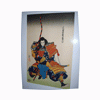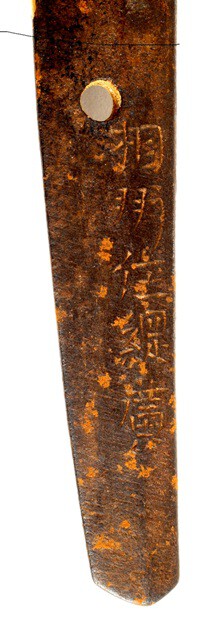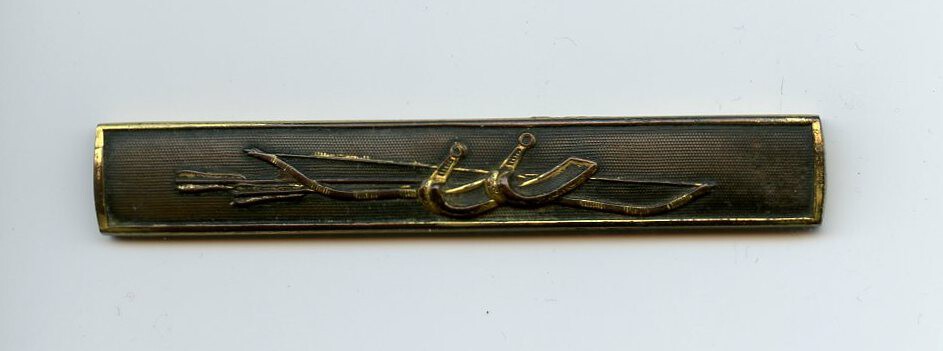-
Posts
334 -
Joined
-
Last visited
Everything posted by edzo
-
Greetings members I'm seeking a confirmation of my translation. I have come up with "Bicchu (no) Kami Yukinobu" on this tang. Any assistance so that i may pursue my research is welcome, thank you in advance, Ed F
-
Dear Mr. Bowen, Thanks for the visit and confirmation. This will give me some confidence researching the smith and to study the blade. When i get to a comfort zone, i may post the results of my research on the nihonto forum once i've determined the period/smith and if it is traditionally made. Thank you very much again, Ed F.
-
Greetings members I'm seeking a confirmation of my translation. I have come up with Soshu Ju Tsunahiro on this tang. Any assistance so that i may pursue my research is welcome, thank you in advance, Ed F
-
Dear Mr. Helm, Thank you for the clarification and your generosity. I became confused and geographically disoriented while researching the tanto. Have a lucky Day, Ed F.
-
Dear Mr. Bowen and Morita, If you should revisit this thread I was wondering if you could lend your thoughts. I am researching a tanto (unrelated to this thread), and stumbled upon Nara Tenzan Shrine. I wondered if it could be one in the same or may have a connection with the sayagaki. This came as a result of 1.), could not find a jurisdiction near Bibai and 2.), researching a signed blade I have, "Nara Sanjo Munechika" (on the blade), if I'm correct on my translation. I read that Tanzan is a Shrine and is the largest repository of early unaltered blades including early Hianjo/Yamato/Hosho etc., utilized to some extent in the kantei process of attribution. I know that usually these signatures are a tribute to someone however, in this research effort there is an exception to that as posted in the links I have included for your information if you are not already aware of that. 1. Under Ko-Hosho paragraph 6. http://www.nihonto.ca/ko-hosho/ 2. Last two paragraphs. http://www.samuraiswords.com/samurai-sw ... d-s/72.htm I guess I'm considering the possibility, though unlikely, there may be a connection with the blade in the sayagaki. Any input woud be appreciated if you are so inclined, Respectfully, Ed F. Please forgive this edit, Is it possible that Goto could be Goro?, not that I am challenging your assistance I found a Goro reference and it made me curious.
-
Dear Mr. Morita and Bowen, Thanks for the follow-up. I wondered because I could not find a Sumiyama, just the Coal town Bibai. It was the primary industry many years ago but declined, as a primary industry in modern times as did its population. That gives relavance to having been found in a cave, maybe an abandoned mine. Thanks again. Respectfully, Ed F.
-
Hi Brian, Thank you again, I drew that conclusion as well and that is why I wrote "a Goto family" in my response. Regards, ED F
-
Dear Mr Bowen, I thank you once again for your assistance. Not seeing a Kao on the saya I thought it may indicate a makers name. It sounds to me that it must have been a valued heirloom of a Goto family. The tag that came with it says it was found in a cave next to a body in Japan around 1940s. The Wak in it is mumei and appears to be traditionally made. Thank You again and have a good week! Ed F.
-
Greetings Members, Am working on a sayagaki, having some difficulty. Any help will be appreciated, Thanks Ed F 1. Nochi-no 2.Fuji 3.Iye? ie?? 4.Mitsu 5. yuku?? 6. Den 7.Rai The Tsuka, 1. Mi 2. ? 3. ? 4. San? Yama? 5. Nochi-no? 6. Fuji? 7. Ta 8. Ro
-
Dear Brian, Thank you for that curtsey. Respectfully, Ed F.
-
Dear Jean, Thanks for that, I have a sense of humor, and it is funny. I was focused on smiths and should have considered the formats of shiragaki which i did review months ago. Need to refresh, and slow down. Respectfully, Ed F.
-
Dear Mr. Shiller, Thank you very much for the translation and correct terminology. I have spent hours on this piece and could not associate it with what I have translated if those are correct. But this I,m sure will give me a direction. Thanks again for sharing your knowledge and time, Respectfully, Ed F. I really lucked out but he is not listed, Its not easy being me but, thanks for the translation I won't miss those characters again.
-
Greetings to members, If anyone is willing and has a chance and can read or is familiar with these characters please let me know. I'm going to continue working on the second section which i think i'm having some luck. Hopefully. Have been wrestling with this using Names and how to read by koop & Inada. No luck or is show as variant but leads me to dead end. Perhaps not using it correctly but doing ok so far. Have surfed quite a bit. Thank you in advance. Gratefully, Ed F
-
How about here as a start Martin, This article you may have seen. Ed F Nihon Koto Shi (History of Koto) By Dr. Honma Junji (43) (P.33) ‘Koto Mei Zukushi’ states that Sadamitsu who was a son of the 3rd Nobukuni, moved to Buzen Province then they added the name of Nobukuni to his mei and Chikuzen Nobukuni of shinto times were his descendants. Also ‘Koto Mei Zukushi’ says that Nobukuni Yoshihisa, Nobukuni Yoshiyasu, Nobukuni Yoshisuke, Nobukuni Yoshimoto were still smiths of Yamashiro Province after 3rd Nobukuni, but their lineages have yet to be studied. There are a few extant works with the smith name of Shigekuni and he is speculated to belong to the Nobukuni school and to have been active after Oei Nobukuni. There is an extant work of Nobukuni with the production date of Seika 1, which is a Chinese Eras and correspondent to Kansho 6 (1465).There is a speculation that many swords by Nobukuni who were active around the Choroku and Bunsei Eras were exported to China. It is also speculated that there are several generations of Ryokai. I have seen a tanto with wide mi-haba and sugu-ha and its mei was done in thicker chiselling and larger characters than that of early generations from the Kamakura Period. I suppose that this Ryokai is one who was active in the Eitoku Era. The later generation of Ryokai moved to Bungo Province in the Muromachi Period and thrived there. They add the name of Ryokai to their mei (Ryokai Sadayuki, Ryokai Yoshizane and Ryokai Naoyoshi) as the smiths of Tsukushi Nobukuni do. They temper sugu-ha with hotsure and occasionally gunome-midare. Swordsmith directories say that a smith called Heianjo Nagayoshi had lived since the former period. There are extant works of Heianjo Nagayoshi with the production dates of the Bunmei, Meio, Bunki and Eisho Eras. There are two generations of Nagayoshi between the Bunmei and Eisho Eras. Koizumi Hisao listed an oshigata of Heianjo Nagayoshi with the production date of Oei 4 (sai-ha or re-tempered) but I am a little doubtful of the authenticity of the mei. The re-tempered blade might cause my suspicion. Nagayoshi after the Bunmei Era demonstrates two different workmanships. One is hoso-sugu-ha, dense ko-itame-hada and whitish jigane. The other is hitatsura, o-midare based on gunome and o-notare. The latter appears to be indirectly influenced by the Hasebe school. His hamon of o-notare has a close resemblance to that of Muramasa of Ise Province and I speculate that there was a technical exchange between them. ‘Kozan Oshigata’ lists an oshigata of Nagayoshi with the mei of ‘Sanshu Ju Heianjo Nagayoshi’. Swordsmith directories say that Nagayoshi of the Bunki Era lived in Ise and Mikawa provinces. Also they list a mei of ‘Soshu Ju Nagayoshi Saku’. He carves so-no-kurikara and shin-no-kurikara on occasion. (Oshigata) “SHIGEKUNI” (P.34) It is said that there are a few generation of Sanjo Yoshinori and they left works with the production dates of the Oei, Hotoku, Bunmei and Eisho Eras. Swordsmith directories list the mei of ‘Sanjo Yoshinori Izumi no Kuni’ and Sanshu Ju Yoshinori’. They temper sugu-ha and o-midare based on gunome. They also made slender tanto with elaborate horimono of shin-no-kurikara. As swordsmith directories describe, Heianjo Nagayoshi and Sanjo Yoshinori belonged to the same school. There is an extant work by Nagayoshi with the mei of ‘Sanjo Nagayoshi’ and the school includes Yoshifusa who signs ‘Sanjo Yoshifusa’ and ‘Heianjo Yoshifusa’, also one of his extant works adds ‘Izumi no Kuni’ to his mei. He occasionally carves Chinese characters like ‘Kimi Ban Zai’ and ‘Heshite Heshite’ on his blades. It is very rare to see the horimono of Chinese characters on koto blades. I have seen a katana with the mei of ‘Kurama Ju Yoshitsugu’ and a tanto with the mei of ‘Kurama Ju Fujiwara no Yoshitsugu Yoshisada’ (collaboration of the two smiths) and a production date of the Meio Era. It is said that they are related to the Sue-Seki school and called ‘Kurama-Seki’. The school also includes Yoshinaga, Yoshishige and Shigetsugu. Their extant works have production dates of the Daiei, Eikyo, Kansho and Meio Eras. It is said that they belong to the Heianjo school or the Nobukuni school. They temper o-notare with yaki-kuzure (deformed midare) and it reminds one of the Heianjo and the Mihara schools. They occasionally carve shin-no-kurikara inside koshi-bi. (Oshigata) “HEIANJO NAGAYOSHI SANSHU KOKU SAKU” “SANJO NAGAYOSHI SAKU” “HEIANJO NAGAYOSHI” “EISHO 1 NEN 3 GATSU” Juyo Token : Katana Mei “HEIANJO NAGAYOSHI” (P.35) 4. Other smiths of the Kinai District As described before, Sanjo Yoshinori and Yoshifusa engaged in sword forging in Izumi Province. There was a school represented by Kaga Shiro Sukemasa in this province. It is said that the ancestor of Sukemasa was Mitsumasa of Kaga Province who was active in the Nambokucho Period. His son Yoshimasa, started calling himself ‘Kaga Shiro’ and lived in Sakai of Izumi Province and Echigo Province in the Oei Era. Sukemasa was a son of Yoshimasa. Suketsugu and Sukemitsu of this school were active around the Tenbun Era. I have not seen extant work of theirs except for Sukemasa. Sukemasa demonstrates a workmanship similar to the Fujishima school of Kaga Province. A katana with the mei of ‘Kawachi no Kuni Shida Gun Deguchi Masashige Saku’ exists. Inferring from the workmanship and nakago, it appears to be a work of Masashige who was a student of Muramasa of Ise Province and was active at the end of the Muromachi Period, though, further study is needed. Swordsmith directories list Arikuni and Arishige, whose ancestor was Arinari of the Heian Period, but there are few extant works by them. The directories also list Munenaga and a few other smiths who are related to Nakajima-Rai, but I have seen no extant work by them. (Oshigata) “SUKEMASA SAKU” Juyo Token : Wakizashi Mei “SANJO YOSHINORI SAKU”
-
Hi Martin, Ill keep my eyes open if anything turns up i send it along Have u been to the International dealers sites, some are a good resource? Regards and good luck Ed F
-
Hi Martin, You may want to look at this site. Ed F http://nihontoclub.com/view/smiths/meis ... =nobuyoshi
-
Dear Mr. Bowen' I recall reading something similar and perhaps I should have footnoted my comments. I appreciate your input and think it may not be of the smith. My focus was that, knowing that the smith's lineage was noteworthy (In my opinion), The signature seemed to conform very much under close examination, to that smith I concluded. Of course, there are expert forgers out there and a higher % of the best are encountered. Thanks again Ed F.
-
Dear Mr. Helm, Thank you for your generosity in sharing such a valuable research effort. It's members like you and others that compliment this forum making is so important to the art, collectors, students and researchers. Respectfully, Ed F.
-
reetings members, For your interest or critique if my research is incorrect. I am a newbie. I concluded that this piece to be shinshinto period 19th cent, and the ko-gatana is signed Shizu Saburo Kaneuji. He may be the 19th generation of the shodai kaneuji, (student of Masamune) and may have been associated with the Kanesade lineage as well. From the signatures I compared strokes, confidence and proportion to known signatures and concluded they are equally executed. The hamon on the blade is similar to that I’ve seen on katana. The kozuka is Shibuichi, and I can’t seem to capture the gray patina of it in the scan. It includes three aoi-mons (Tokugawa mon), flush inlaid brass plate, don’t think gold, with engraved leaves. If anyone is so inclined your opinions will be welcome. Thank you in advance, Ed F.
-
Dear Members including Mr. Bowen, P. Klein and Brian thank you very much for your valued input on this thread. Thank you Mr Bowen for posting the up-coming event in Minneapolis this October which I am aware of from a previous post that u made. I will discuss it with the administrator (owner), I previously recommended that they located and paperwork they might have and prepare for the possibility they may to invest $ (shinsa etc.), on part of their collection. I believe the issue for them is financial, the other is time. Mr. Klein, thank you for the information that you so generously posted. I have only seen one other signature by this artist papered, see http://www.shibuiswords.com/goto-ryu_fi ... %25204.gif but after reviewing your example I most convinced the piece is gimei, that together with a more objective look at the workmanship, specifically the nanako in comparison to that found on their tsuba. And thank you Brian for that comment, the piece does not scream out. Respectfully yours, Ed F.
-
Dear Mr. Morita, Thanks again, I understood that to be the case I am seeking and research to determine if it is gimei, which may be the case. I am not qualified to make that determination but hoping some day to posses that skill. Thank You very much again. Ed F.
-
Dear Mr. CBowen, Thank you for your interest and effort. I'm a beginner learning and researching this piece, among others. Many of the pieces that I have viewed (photos), did look more masterfully executed but this Kozuka has seen better days and the work looked somewhat comparable to a Goto Senjo and a Sekijo I found on the internet. Your suggestion is fodder for me to continue my research, my library is limited and am still waiting for more books to come. I did think that the Hukumikin was a little sloppy. Thank You again for your generous input. Respectfully, Ed F. Edit, I just wanted to add that you may be correct in your comment.
-
Dear Mr Morita, Thank you for taking the time and sharing the knowledge. That is awesome morita san. I referred to my "Japanese names and how to read them", and it noted it as a variant i thought of Ishi, that must be what was meant in the book by the author. Respectfully, Ed F.
-
Greetings to all, Thanks to the generous suggestion of Mr Geo Trotter, I changed direction on "Ishi" and researched Seki, as the first character and came up with Goto Sekijo 石乗 (1609-1660) whose given name was Sonjuro. Later he took the name Yoshibei Mitsuyoshi. He became the hereditary 3rd head of the Goto Kihei family upon the death of his father Takujo Mitsumune. He lived in Kyoto. One characteristic of Goto work is the fine nanakoji which this has including and the ura is Hukumikin. I also noted that the signature is found on the edge of on this kozuka it is referred to as kibata-mei which was done by some Goto smiths. My concern is the extra stroke in the first character however I read that that was not unusual for some smiths. If anyone has a chance, any input or redirection would be appreciated, Thanks you all very much, Ed F
-
Dear Mr. Hallam, I can't add anything that has not been said except "WOW"!, ED F. Great take, thank you for that.













